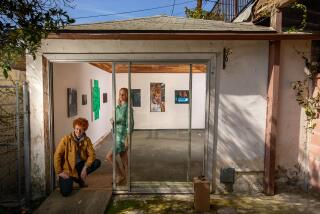Built Prized Campus Collection : UCLA Art Professor Wight Dies
- Share via
Frederick S. Wight, the venerable elder statesman of the Los Angeles art scene and an acclaimed painter in his own right, has died.
The professor emeritus of art at UCLA--which named its galleries for him--was 84 and died Saturday at a local hospital.
For 20 years (1953-73) Wight presided over what has come to be one of academia’s most prized collections.
And he built it out of an initial annual budget of $3,500 when he came to Los Angeles from the Contemporary Art Institute in Boston.
At Westwood he was heir to both a tenuous and barely established collection and the incongruous title of “curator of art materials.” With determination and the help of some of his East Coast contacts, he organized exhibitions of major 20th-Century American artists and sent them on tour, using the proceeds to add to UCLA’s own collection. Among them were paintings by Henri Matisse, Charles Sheeler, John Marin and Morris Graves.
An early coup was Wight’s luring of Fred Grunwald’s collection of graphic arts to the campus.
Adviser to Murphy
Dr. Franklin Murphy, the former UCLA chancellor who left a singular imprint on the university with the sculpture garden assembled by him and which bears his name, remembered Wight Monday as “my closest adviser” in the years when those prized art objects were being gathered from around the world.
These came to include the interpretations of Jacques Lipchitz and Jean Arp.
And William Wilson, today The Times art critic but an art student at UCLA in the years of Wight’s tenure, recalled that his former professor “showed us art from around the world we had never before seen.”
Wight’s forte, he liked to say of himself, was in “presenting art to the public.” But his “ruling passion” was the dozens of landscapes he painted which roved between symbolic imagery and abstractions. He painted palm and Sequoia trees lighted by a burning sky or moons and comets skidding across crimson heavens.
Wilson, in a 1981 review of an exhibition at the Municipal Art Gallery, said the “most remarkable quality (of his works) is that every one convinces that Wight actually saw that .”
Diverse Settings
The paintings were seen in such diverse downtown Los Angeles settings as the Arco Center for Visual Art and Angelus Plaza, a high-rise community of seniors, as well as the Ankrum and Newspace galleries. They also were exhibited at museums and galleries across the nation.
A native of New York City, Wight graduated from the University of Virginia and then studied in Paris from 1923 to 1925. He painted and exhibited through the 1930s and then served with the Office of Strategic Services, forerunner of the Central Intelligence Agency, in World War II.
After the war, at age 42, he earned a master’s degree from Harvard and joined the Boston institute before coming West to teach, paint and write.
He authored a series of what could have been semi-biographical novels of youth set in the New York City of the 1930s and two art books--”Van Gogh” and “Goya.”
Wight prepared the catalogues for the exhibitions of the contemporary artists he generally favored, and was at the vanguard of establishing the West Coast as a significant repository of reputable art works.
Wilson recalled a long-ago Esquire magazine article dealing with people outside New York City who had been particularly influential in the art world.
“Fred Wight was the only one mentioned from California.”
He is survived by his wife Joan and one son. At her request, there will be no services.
More to Read
The biggest entertainment stories
Get our big stories about Hollywood, film, television, music, arts, culture and more right in your inbox as soon as they publish.
You may occasionally receive promotional content from the Los Angeles Times.










